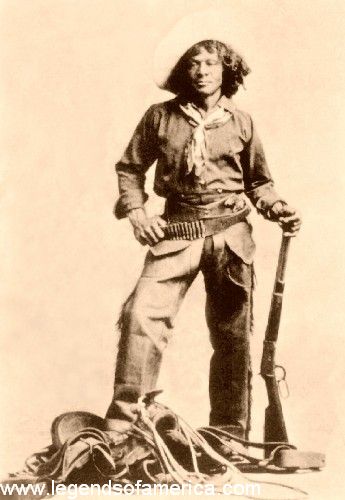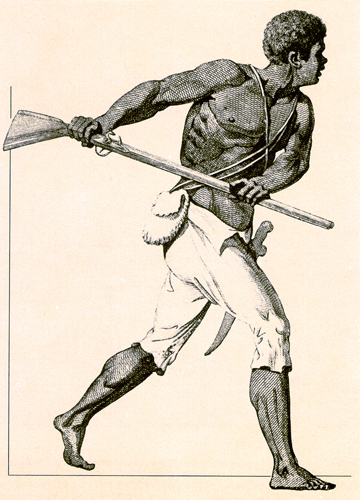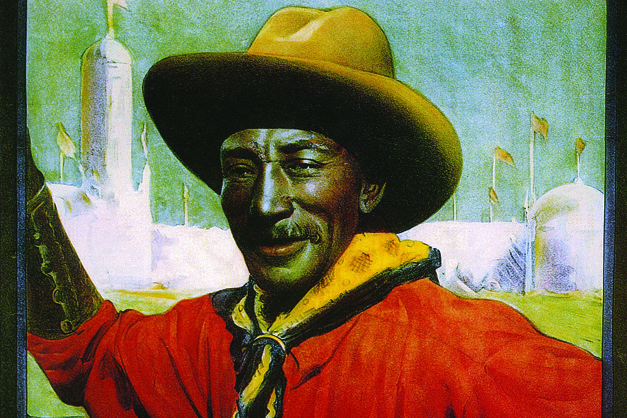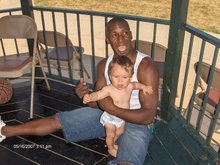The Cowboy is an all American character, a living symbol to a romantic time. Country and Western music, westerns full of quickdraw gunfights and rodeos are all remnants of a culture that helped glorify the Western United States.
In The early 1800's, vast stretches of grassy plains teaming with wildlife (free cattle and free land) lured all walks of life to the lawless lands of opportunity. The Darwinian lifestyle quickly earned the territories a name " The Wild West".
In fact many territories were conquered by settlers. The biggest army in the world was the armed to teeth, poor , eager American citizen.
 The popular television show Bonanza also provided a sanitized version of life on the Ponderosa range. These popular depictions of cowboy life came well after hundreds of dimestore novels made there way east out of the western territories during the 1860's.
The popular television show Bonanza also provided a sanitized version of life on the Ponderosa range. These popular depictions of cowboy life came well after hundreds of dimestore novels made there way east out of the western territories during the 1860's.
Lu Vason started the rodeo twenty three years ago in Colorado. The producer and former manager of The Whispers, The Natural Four and The Pointer Sisters ironically decided to trade in the silk suits and handkerchiefs for a lariat and spurs.
 "I am a producer and this is a business endeavour" he reminded.
"I am a producer and this is a business endeavour" he reminded.
 Texas during the 1850's was still a very dangerous place. There was a constant threat of attack. Cunning , skill and luck were requirements for anyone trying to reach adulthood in the feral society.
Texas during the 1850's was still a very dangerous place. There was a constant threat of attack. Cunning , skill and luck were requirements for anyone trying to reach adulthood in the feral society.
 Love's book, The Life and Adventures of Nat Love gave a full acount of his exploits on the plains from his early days in slavery to his teenage years fighting The Yellow Dog Tribe.
Love's book, The Life and Adventures of Nat Love gave a full acount of his exploits on the plains from his early days in slavery to his teenage years fighting The Yellow Dog Tribe.
 He mentions just about every notable person of the time. Jesse James, Buffalo Bill, Billie the Kid and Kit carson all made appearances in his book. The historical accuracy confirmed by his own legend.
He mentions just about every notable person of the time. Jesse James, Buffalo Bill, Billie the Kid and Kit carson all made appearances in his book. The historical accuracy confirmed by his own legend.
Before the transcontinental railroad spanned the entire United States, goods and services were still needed in the rapidly expanding western territories.
The expansion west , like any other expansion, was fueled and sustained by trade and commerce. The lawless nature of the new territories required a rugged disposition for anyone venturing west of the Mississippi River.
In fact many territories were conquered by settlers. The biggest army in the world was the armed to teeth, poor , eager American citizen.
Cowboys were the main characters in this storied chapter in American History. From the cattle ranches of what is now Texas to the expansive plains of the 'great midwest' a motley collection of rejects from every corner of America made a home on the range.
There are many popular stories, legends, that have stood the test of time regarding the supposed romantic life these men led. Lonesome Dove, a well read story of the Good night-Loving trail and the cowboys that ran it was made into a television minisereies.
Gen X question: Who can forget Silver Spoon's Ricky Schroeder returning to T.V., finally playing a man?
 The popular television show Bonanza also provided a sanitized version of life on the Ponderosa range. These popular depictions of cowboy life came well after hundreds of dimestore novels made there way east out of the western territories during the 1860's.
The popular television show Bonanza also provided a sanitized version of life on the Ponderosa range. These popular depictions of cowboy life came well after hundreds of dimestore novels made there way east out of the western territories during the 1860's.
A good story was part of the newly emerging Cowboy culture. Spinning a good yarn was as important as the round-up. The evening campfire would glow bright into the eyes of the storyteller who had the ability to captivate his audience with glorious tales of triumph and loss. The ancient art of the griot living through these mercenaries of manifest destiny. There were also few women around so a good imagination provided an escape from the present reality which was full of danger and back-breaking hard work.
The new frontier provided many opportunities for the men that chose the life. Race was not always an issue. Cowboys came in all shapes and sizes. The majority were white but at least a third were black. Many of the newly freed and runaway black men made an equal living working alongside their white counterparts; often times being paid the same to do the same.
The risk was the same or everyone, the threats from outlaws and Indians made life very dangerous for the hardworkng cowboys. The reward for their hard work was great, the money for a successful run reaped fortunes for the cattlemen and their drivers. The rich stories they told reflect a life of adversity and accomplishment.
The range was a place of equality where natural law, not man's law, prevailed.
What Did They Do?
The term Cowboy has been used for a little over a hundred and fifty years. According to legend it originated from a southern slave owner who hired out his 'cowboy ' slaves to manage herds in his county. They were noted for their excellent manipulation of a large herd with only a dog and salt. Another legend says the term comes from the english transalation of the Spanish term vaqueros which described the south of the border version of cattlmen on horseback.
vaqueros which described the south of the border version of cattlmen on horseback.
 vaqueros which described the south of the border version of cattlmen on horseback.
vaqueros which described the south of the border version of cattlmen on horseback.
The Texas territory before the American expansion was a haven for Missions and Spanish forts. The cattle the Spaniards left behind after Mexican independence roamed the huge plains of Texas wild and free.
The Indians and Mexicans had more than enough cattle to deal with ( easily over 100,000 in Texas). The American expansion west brought more people. And with them a demand for beef. The large herds were rounded up and the techniques employed by the Indigenous Indians and Mexicans on horseback were copied and perfected by the newest settlers.
A cowboy rides a horse, a cowboy has skills in the saddle. The ability to control a a large number of cattle on horseback is the backbone of the trade. The cowboy had to do many things to be considered a good cattleman. Good shooting skills had nothing to do with cattle but would increase the lifespan of any man on the range during the cattle drive. The ability to handle a stampede ( an out of control herd) and withstand an attack by Indians and outlaw at the same time could not be taught. Many good men died on the trail.
One Example of Excellence
Bill pickett is the most famous of all Black Cowboys. "Imagine creating your olympic event...Bill Pickett did that with rodeo" shared Lu vason of the Bill Pickett Invitational Rodeo
Bill Picket was born in Texas in 1870. He is legendary for reating the event bulldoging. as child he used to watch the buldogs take down 1000lb bulls on the ranch. As a man he applied the technique to earn his immortal reputation.
It was a suicidal, daring act. He would ride alongside the bull at full gallop, jump off of his horse straddling the bull by the horns, somehow sliding around the front of the bull while turning its head. As if it wasn't daring enough, he raised the 'insane bar' by biting the top lip of the bull and then would raise his hands showing complete control of momentum and direction of the subdued behemoth. One can only imagine the looks of astonishment on the faces of the first witnesses to this amazing feat.
The modern version of 'Bulldogging' does not include biting the top lip. The originator, Bill Pickett ironically died from a kick to the head, on the rodeo circuit , at the age of 62 still dazzling audiences with his amazing performances. The fact he lasted that long is a testament to his skills when everything is on the line.
"He really is beyond compare, he created the competition, he was the best" Vason said.
Vason's rodeo is all about education and fun and choosing Bill Pickett as it's namesake was easy .
How It Started For Lu
Vason's interest in rodeo is an exercise in irony. Its the part of his life story that I love. Some of us, me included, never know where we are going to end up; we just know we are going to make it. When Vason graduated highschool he did not know he would be running the number one black rodeo. The Berkeley High Graduate (Berkeley Ca) got his start writing for a small African American Newspaper called The Berkeley Post in 1962.
He segued into entertainment, managing local acts. He was a shameless self promoter and through his efforts he helped many others advance their careers.
Lu Vason started the rodeo twenty three years ago in Colorado. The producer and former manager of The Whispers, The Natural Four and The Pointer Sisters ironically decided to trade in the silk suits and handkerchiefs for a lariat and spurs.
"Cheyenne , at the time, was open, clean and there weren't many people" He said referring to the isolation and sparse population at the time. " I had knowledge of history. What I considered a good knowledge, a thorough knowledge. There were a lot of guys missing from the history books and the westerns that I saw" he paused.
"Black Guys" he continued "I started the rodeo to include that piece of history, for the reverence that was missing...Cheyenne was the place to do it".
Lu Vason does not consider himself a cowboy. He does not ride a horse, he is a businessman first.
The invitational has an international reputation and attracts Black riders from all over America. Most are already in other pro Rodeo circuits.
 "I am a producer and this is a business endeavour" he reminded.
"I am a producer and this is a business endeavour" he reminded.
When asked, he had to agree "Oh yeah, an educator too"
Sounds Good Lu, sounds good. But remember, no one is learning shit until he gets paid.
Another Amazing Black Cowboy
Bose Ikard was born a slave in Mississippi in 1843 to a prominent southern Doctor. In his childhood he acquired all the requisite skills for life on the range. His hard life as a slave prepared him for just about any challenge.The many tasks he mastered helped make him a valuable commodity in the newly emerging territories.
 Texas during the 1850's was still a very dangerous place. There was a constant threat of attack. Cunning , skill and luck were requirements for anyone trying to reach adulthood in the feral society.
Texas during the 1850's was still a very dangerous place. There was a constant threat of attack. Cunning , skill and luck were requirements for anyone trying to reach adulthood in the feral society.
A man could earn a reputation real fast in the territories just by surviving past fifteen.
Ikard was young, smart and eager. By the end of the civil war he had gained his freedom and proved his worth as a good cowhand and sure-footed fighter.
In 1866 he officially beame a cowboy working under traildrivers Oliver Loving and Charles Goodnight.
Early in his traildriving career,the man that gave him a job, Oliver Loving was killed. He fell victim to Comanches who regularly attacked the cattlemen. Loving's partner, Goodnight kept Ikard on his crew and they became fast friends.
Through the years they successfully repelled indians, outlaws and steered stampeding herds. Ikard finally settled down in 1870 and would live to be 86 years old. The father of fifteen children and a celebrated friend of Charles Goodnight. The trailblazing co- creator of the legendary Goodnight Loving Trail.
One More Example
Nat love was a writer, Pullman Porter, card shark and cowboy. He personified the true 'Wild West' renaissance man. Love lived a full life on the trail working as a cowboy with many different outfits.
 Love's book, The Life and Adventures of Nat Love gave a full acount of his exploits on the plains from his early days in slavery to his teenage years fighting The Yellow Dog Tribe.
Love's book, The Life and Adventures of Nat Love gave a full acount of his exploits on the plains from his early days in slavery to his teenage years fighting The Yellow Dog Tribe.
An excerpt describes his life: "I had full confidence in myself as being able to take care of myself and making my way." another excerpt: "I gloried in the danger, and the wild and free life of the plains, the new country I was continually traversing, and the many new scenes and incidents continually arising in the life of a rough rider"
Rough Rider? Sounds Like D-Block
 He mentions just about every notable person of the time. Jesse James, Buffalo Bill, Billie the Kid and Kit carson all made appearances in his book. The historical accuracy confirmed by his own legend.
He mentions just about every notable person of the time. Jesse James, Buffalo Bill, Billie the Kid and Kit carson all made appearances in his book. The historical accuracy confirmed by his own legend.
I beleive him because I have met a lot of 'Pop Culture' celebrities myself but I don't talk about it because when I start name dropping (like I am about to do right now) most people think I am lying.
There is a magic in being at the right place at the right time.
If you really know me- you know.
Nat Love , also known as 'DeadwoodDick', had earned his reputation early. He is a legendary figure who changed with his surroundings.
The need for cowboys dwindled with the growth of the railroad. When the Transcontinental railroad was complete a lot of cowboys had to find otherways to make a living.The great iron horse would rumble across the plains bringing more people and change. Nat yearned for the life on the trail but would ultimately adopt the soft lifestyle working on the railroad as a Pullman porter. He continued to live on his own terms till he died in 1921, leaving behind a legend and many friends.







3 comments:
I stumbled across your blog, and after reading a few posts, had to compliment your voice. Writers able to parlay personal experience, pop culture, and historical insight into (relevant) social commentary are few and far between. I must admit that, while reading your work, I started a list of interesting sources/readings from my own studies in American material culture and think you would find several very interesting. Let me know if you would like me to pass them along.
Kates I would be happy to learn more...
Michael Kammen's Mystic Chords of Memory: The Transformation of Tradition in American Culture (1993) is a great resource if you are interested in trends in our country's historical memory. Your last post on blackface made me think about the performance of another racial stereotype: Irish Paddys (or whiteface). For more on this, see James P. Byrne, “The Genesis of Whiteface in Nineteenth-Century American Popular Culture” MELUS (Fall-Winter, 2004). Brian F. LeBeau talks about both Irish and African American constructions in the imagery of Currier and Ives (19c. American printmaking firm) in his Currier and Ives: America Imagined (2001). I find the overly caricatured "Darktown Comics" particularly fascinating (in a somewhat disturbing way). For more direct discussion of these, see LeBeau's "African Americans in Currier and Ives's America: The Darktown Series" Journal of American and Comparative Cultures 23.1 (2000). If you really want to get into how certain topics/imagery have been filtered out of collective histories, check out the progression of Harry T. Peter's "histories" of Currier and Ives. Or just read Holland Cotter's "ART VIEW;Currier & Ives, as Telling as Ozzie and Harriet" NY Times (July 14, 1996). This is also an amazing website on black Americans in Harper's Weekly illustrations (and tons of great links): http://blackhistory.harpweek.com/
I hope some of this strikes your interest.
Post a Comment